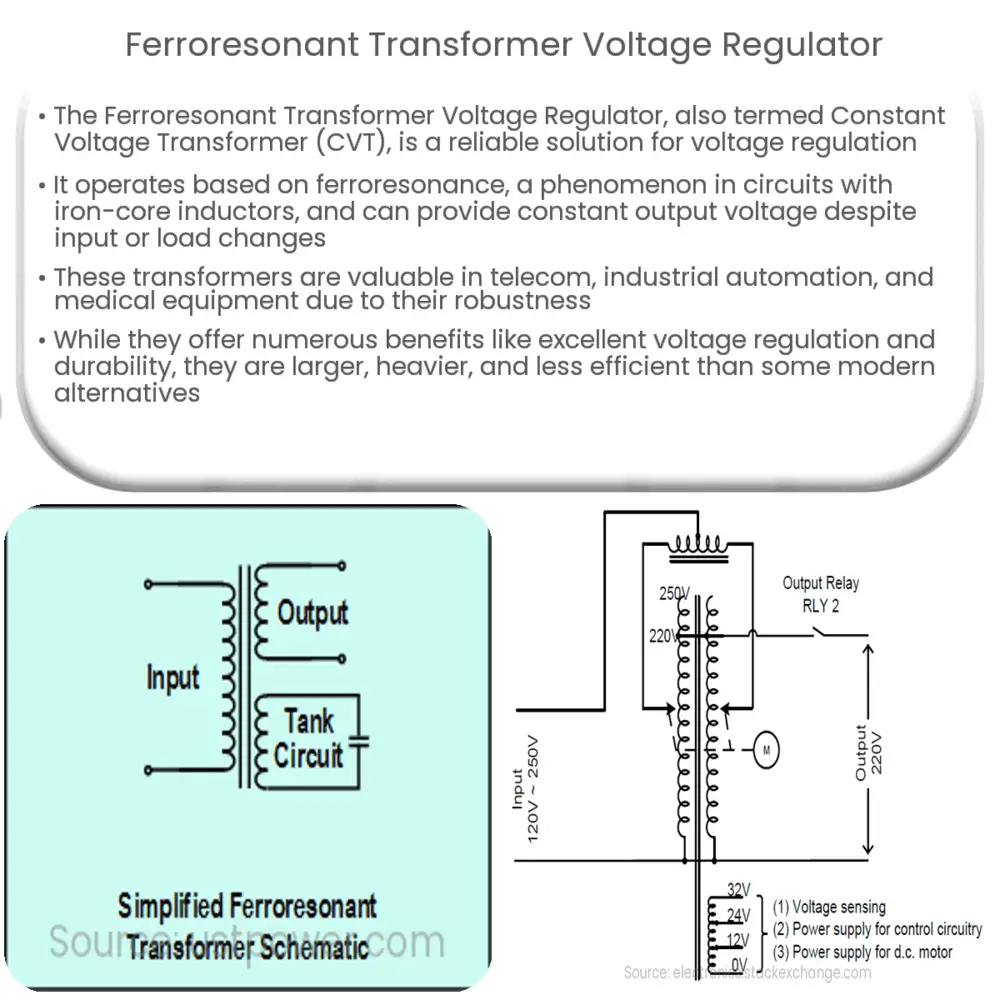Explore the functionality of Ferroresonant Transformer Voltage Regulators, their design, operation, applications, benefits, and drawbacks in power regulation.

Introduction to Ferroresonant Transformer Voltage Regulators
The world of electronics and electrical engineering presents a myriad of solutions for managing and regulating voltage levels in electrical systems. Among these solutions, one of the most reliable and efficient is the Ferroresonant Transformer Voltage Regulator, also known as a Constant Voltage Transformer (CVT).
Understanding Ferroresonance
Ferroresonance, the principle underlying the operation of these transformers, is a phenomenon that occurs in electric circuits containing iron-core inductors or transformers. It’s a type of resonance that involves a nonlinear magnetizing inductance. It can generate high and potentially damaging overvoltages in electrical systems. However, when harnessed and controlled, this phenomenon can be used beneficially, such as in the operation of ferroresonant transformers.
Design and Operation of Ferroresonant Transformer Voltage Regulators
A typical ferroresonant transformer consists of a main winding, connected to an AC source, and a secondary winding, which delivers the regulated output. Most notably, there’s an additional ‘ferroresonant’ winding (or ‘tank’ circuit) connected in series with a capacitor. This setup creates a resonant circuit that can store and release energy, thereby providing voltage regulation.
- Main Winding: It is connected to the input voltage source. This winding is responsible for the primary conversion of electrical energy.
- Secondary Winding: The secondary winding is connected to the load. It receives the transformed voltage from the main winding and delivers it to the load.
- Ferroresonant Winding: The ferroresonant (or tank) winding is magnetically coupled to the main winding. When paired with a capacitor, it forms a resonant tank circuit that can absorb and release energy, providing voltage regulation.
The unique design of the ferroresonant transformer allows it to maintain a nearly constant output voltage, even when there are significant changes in the input voltage or load conditions. This is why it is often referred to as a Constant Voltage Transformer (CVT).
The Role of Ferroresonant Transformers in Voltage Regulation
Regulating voltage is crucial in electrical systems to prevent damage to equipment and to ensure safe and efficient operation. The ferroresonant transformer provides a reliable and robust solution for this need, capable of withstanding voltage sags, surges, and even short-term outages. This resilience to power disturbances makes the ferroresonant transformer an ideal choice for critical power applications.
Applications of Ferroresonant Transformers
Ferroresonant transformers have widespread use in various industries due to their robustness and reliability. They are particularly valuable in environments where power quality can be an issue, or where sensitive equipment requires a stable and reliable power supply. Some common applications include:
- Telecommunications: These transformers are used in telecom systems to provide a stable power supply, ensuring clear, uninterrupted communication.
- Industrial Automation: In automation processes, they safeguard against voltage fluctuations that can disrupt operations or damage sensitive machinery.
- Medical Equipment: In healthcare settings, the reliable power supply from ferroresonant transformers is critical for maintaining the function of life-supporting and diagnostic devices.
Benefits and Drawbacks of Ferroresonant Transformers
Ferroresonant transformers provide several advantages, including excellent voltage regulation, isolation of output from line noise, high surge capability, and intrinsic short-circuit protection. They are known for their durability and require minimal maintenance, making them a cost-effective solution in the long run.
However, these transformers also have certain limitations. They are typically larger and heavier than other types of transformers. They can also produce more heat and have a higher no-load power consumption. Their efficiency is less than that of modern switched-mode power supplies.
Conclusion
In conclusion, the Ferroresonant Transformer Voltage Regulator is a significant device in the realm of power electronics. It offers a robust solution to voltage regulation, especially in scenarios where power quality is critical. While it does have its limitations, its benefits, particularly its resilience to power disturbances and low maintenance needs, make it a popular choice for many applications. As technology advances, it will be interesting to observe how the design and utilization of this transformer evolve to meet the changing demands of the electrical and electronics industry.

